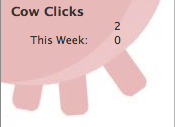[Cross Posted from Culture Digitally]
I’ve clicked a cow. Twice. One Kotaku article and a game designer’s reflections on that article got me to thinking about Ian Bogost’s Cow Clicker, again.I first clicked a cow when I added Cow Clicker as a Facebook application. I’m sure Ian could even tell me the day that occurred. That’s the strange thing about Facebook applications and the kinds of access they provide their developers. But that isn’t the point here. I clicked my cow for a second time during the Game Developer’s Conference (GDC) in 2011. This was an interesting moment for Cow Clicker and for Ian I suspect. Its a moment that isn’t mentioned in either of those articles. It was the time of Cow Clicktivism. Ian partnered with Molleindustria and Oxfam to ostensibly turn cow clicks into real cows. It was hard to tell if, or where the irony ended and seriousness began.
Perhaps it was a first volley in what eventually landed in a pile of bull-shit. I’m not sure. There are certainly enough allusions to broken realities, Gamification and tongue-in-cheek revolutionary game designers. But this wasn’t the first time a struggle was being waged between ironic accounts of shit and sincerity about shit. It was the subject of his GDC talk, “Shit Crayons,” because he was also taking it seriously. The subject of Wole Soyinka haunts the entire thing, much like I suspect prison haunts anyone who’s had to partake.
So why cows and cyborgs then? Because I see, in all of this, parallels to Donna Haraway’s cyborgs. As I read about Cow Clicker and reflect on players and the designer’s intention, I see an old problem. The tension for the academic working in an ironic mode isn’t just that someone might not “get it.” But that in making that ironic turn, we’re also making a playful commitment to the very object we critique. It enters one into a game of cat’s cradle with another player or group of players that are going to take up and read / re-read / interpret it in ways that are unpredictable. Of course Haraway jettisoned her cyborgs for dogs and companion species.
The ironic mode is seductive, playful and fun… at first. But there is also a commitment that one makes in good irony that demands something in return, almost a blood oath. Indeed, if Cow Clicker, like A Slow Year, is a meditation, then it demands commitment to think deeply and carefully about something even if one’s conclusion is to jettison Cows to heaven. Of course I wonder, if Cows are Cyborgs, what is Ian’s companion species?
In the end, it is the Cow’s creator and rapturer that summarizes it best:
Or, it’s both. Or all of them.
I do think this account is a particularly generous, designer-oriented reading. It’s not wrong. It’s beautiful. I see it like that sometimes. But it’s not the whole story either. Like so many things.

